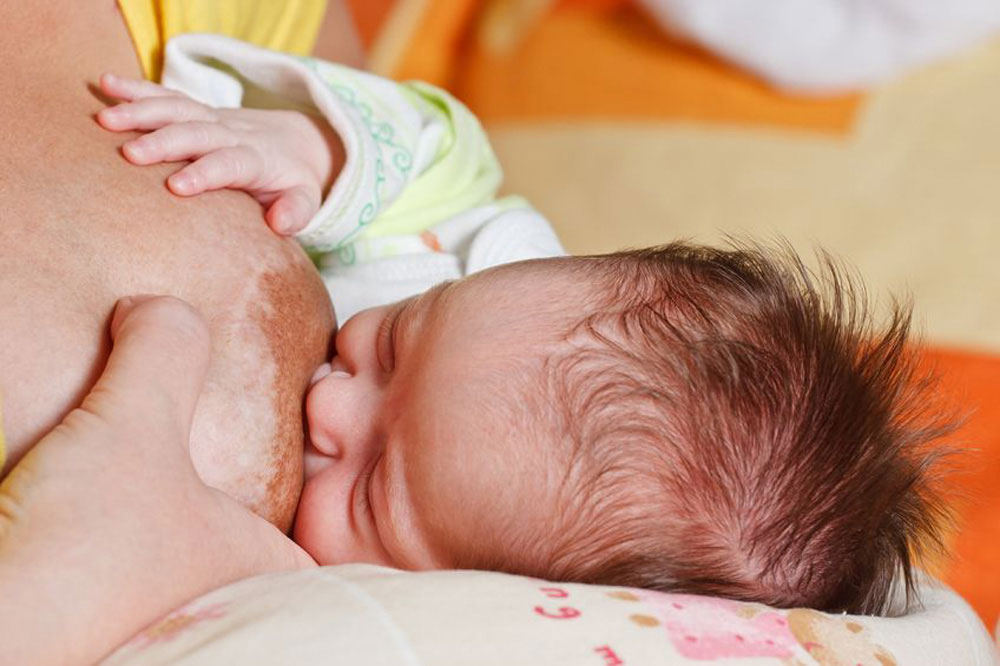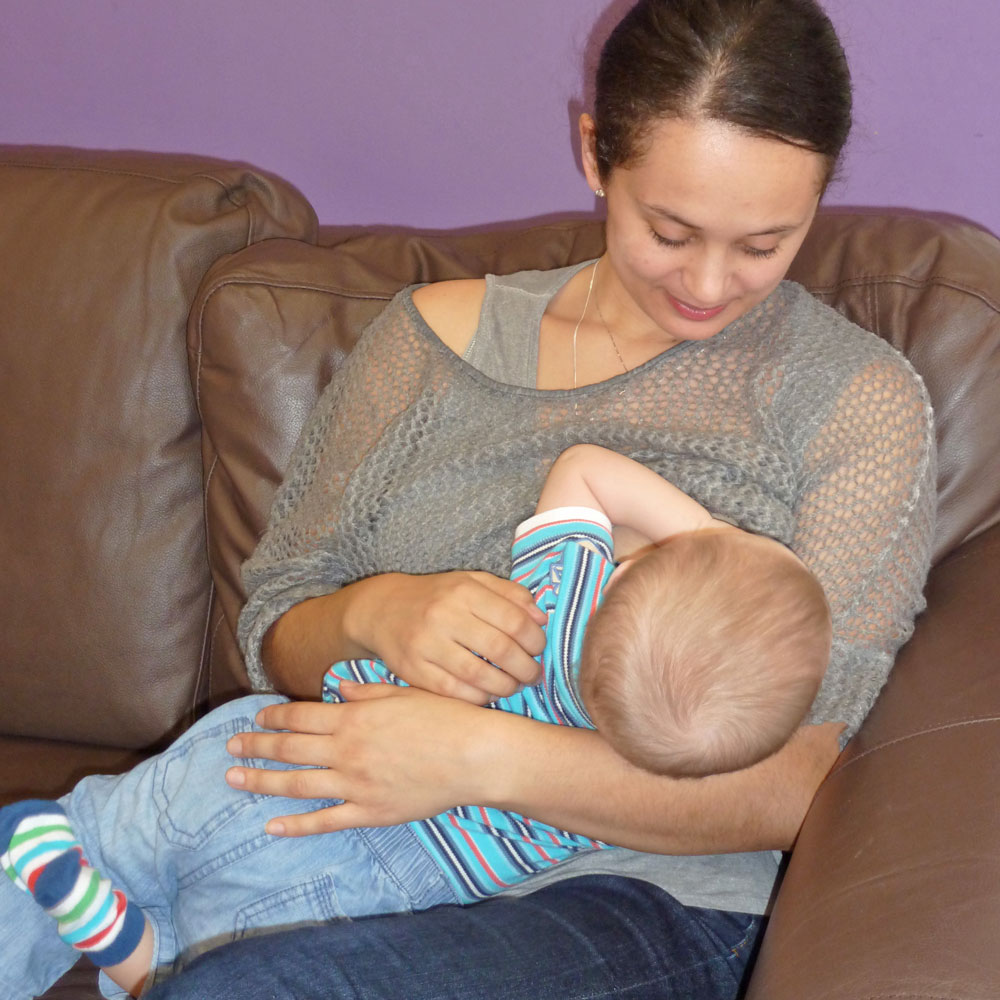Breastfeeding is normal and natural and is not supposed to hurt. If breastfeeding hurts at any time check through our suggestions and links below and seek help from your IBCLC lactation consultant or breastfeeding helper. Without quick help, pain during feeding can quickly cause sore or cracked nipples. If breastfeeding hurts, because your baby isn’t attached to the breast (latched) correctly, this can reduce your milk supply leading to a baby who seems to be constantly feeding, fussing or pulling off the breast or one who isn’t gaining much weight.
Why does breastfeeding hurt?
The most likely reason for breastfeeding to hurt is when a baby attaches to the nipple without a deep mouthful of the surrounding breast tissue. If the nipple is not far enough into the baby’s mouth, it will tend to be pinched between the tongue and the roof of baby’s mouth and this will be very painful. Your nipple may come out of baby’s mouth slanted like the top of a new lipstick instead of rounded like a cherry on a cake. Nipples may even look white for a few moments as if the blood has been squeezed out of them.
Shallow latch (painful)
Latching mostly on the nipple rather than the breast is often called a shallow latch. In a shallow latch your baby’s tongue won’t be in the best position against the breast. Your baby may find it difficult to get enough milk and breastfeeding is more likely to hurt. Babies breastfeed many times a day so it won’t take long for breastfeeding in a painful latch to lead to sore nipples including cracked or grazed nipples or blisters on nipples.
Deep latch (comfortable)
When the breast fills the baby’s mouth in a deeper latch; a baby’s tongue cups more of the milk making or glandular tissue in the breast. In a deep latch the nipple is protected from the painful pinch because it is deep in a baby’s mouth at the junction of the hard and soft palate.
Babies Need a Big Mouthful
It’s called breastfeeding (not nipple-feeding) for good reason. When your baby has a big mouthful of breast beyond your nipple, that’s when it’s comfortable. And that’s where the milk is. So when it feels good, it is good.

How to get a deep latch
- Positioning your baby. The way your baby is held can make a big difference to how well he can latch on and breastfeed. In the right position your baby may automatically improve his latch and know what to do. See the articles Breastfeeding Positions for Newborns, Breastfeeding Videos and Why Skin to Skin? for ways to hold your baby so he can get a big mouthful of breast easily and get a deeper latch.
- Attaching your baby. In addition to the way you hold your baby, there are a number of techniques available to help your baby get a deep attachment. See Latching Tips for further information.
- Get help. Although pictures and videos can be helpful, if you are struggling to get comfortable the best way to check yours and your baby’s position is to see a breastfeeding specialist in person.

My health visitor says the latch looks fine, but I still have sore nipples
Simply looking at a baby’s latch doesn’t tell the full story about what is happening to the nipple inside a baby’s mouth. If breastfeeding hurts there is still something wrong. Try to find an IBCLC lactation consultant or another breastfeeding specialist for a second opinion. It can be difficult to find the cause of the pain sometimes but painful feeding is not normal. Possible reasons for ongoing pain include:
Latch not deep enough
One helper’s idea of a good latch may be quite different from another’s particularly if they haven’t had much training in breastfeeding support. Before assuming something more complex is the cause of breastfeeding pain it can be helpful to check positioning and attachment with a specialist. For information on latching comfortably see Latching Tips and Causes of Sore Nipples.
Nipple vasospasm
Vasospasm of the nipple is when the little blood vessels in the nipple contract or narrow. This phenomenon can be triggered when the nipple is squeezed tightly in a shallow latch so that the tiny blood vessels in the nipple are compressed, leading to decreased blood flow and oxygen in the nipple. When baby lets go of the nipple it may look white where the blood has been squeezed out of the nipple and the nipple may look misshapen where it has temporarily been squeezed out of shape. As the blood returns to the nipple, it can be very painful causing a deep throbbing, burning type pain. Nipple vasospasm can also be triggered by other causes eg stress, cold temperatures or exposure to cigarette smoke, so even if breastfeeding is comfortable this can be an explanation for unexpected nipple pain. For more information on causes and prevention see Nipple Vasospasm and Breastfeeding and Latching Tips.
Tension or compression from the birth
Any tension or compression from a baby’s birth may affect the nerves and muscles involved in sucking and swallowing and affect breastfeeding comfort. This could cause high muscle tone, a tight jaw, poor tongue movement or a preference for one breast over another. Forceps, ventouse or cesarean deliveries tend to be the most common causes, but sometimes even in an intervention free birth there can be physical issues due to the way a baby was positioned in the uterus. Some mothers find body work such as cranial osteopathy from a skilled therapist can improve things, particularly if their baby has had a difficult birth.
Fast let-down and oversupply
If a mother has a very fast flow or seems to have too much milk, a baby can learn that by pinching the nipple they can slow down the flow of milk which can cause sore nipples. A breastfeeding specialist can suggest ways to help your baby cope with the flow and see What is a Fast Let-Down? and Oversupply of Breast Milk.
Allergies (when baby is in pain)
An unexpected cause of mysterious nipple pain—when latch and positioning might look fine—could be associated with a baby’s pain or discomfort. Lactation consultant and author Robyn Noble explains that if a baby is uncomfortable or in pain they can be very tense, especially around the jaw, and tend to clamp down on the breast. Noble calls this a hypertonic bite response and sees it frequently when a baby has a food allergy to something from mother’s diet that is present in breast milk. Hypertonic bite response may cause soreness and marked creasing to the nipple, possibly extending to the areola (the darker area of skin around the nipple). 1. When the cause is food allergy related there will usually be other symptoms see Milk Allergy in Babies, and symptoms can often be helped when the mother follows an elimination diet.
Tongue function
If the membrane under a baby’s tongue (the frenulum) is very short or tight it can sometimes prevent the tongue from moving properly. In some cases, this can be a cause of painful breastfeeding, even with very careful positioning. For help with breastfeeding, contact an IBCLC lactation consultant. They may suggest tailored positions for you and your baby, or trying some simple tongue exercises to improve tongue function and strength to make breastfeeding more comfortable. Sometimes body work may be helpful to strengthen muscles involved in feeding. Your lactation consultant may recommend you see a tongue-tie practitioner to evaluate your baby’s tongue function for a procedure to release the tongue-tie (a frenotomy). See Is My Baby Tongue Tied? for further information.
Nipple confusion
Sometimes a baby who has had bottles will try to apply the way they get milk from the bottle (like sucking through a straw) to the breast—and this can cause pain. Over use of pacifiers might also cause a different suck for some babies. It can help to try to avoid bottles and dummies completely while a baby learns the right technique. If supplements are needed you could try cup-feeding or a supplemental nursing system instead. However using these Tips to Bottle Feed a Breastfed Baby and the ideas in Best Bottle for a Breastfed Baby can help to make bottle feeding more like a breastfeed. Pacifier, Dummy or Soother—Yes or No? has more information about using a pacifier.
Other causes of nipple pain
Although attachment and positioning are generally the main causes of painful feeding, other possibilities include:
Poorly fitted breast pump
If a mother pumps regularly alongside breastfeeding, a poorly fitted breast pump could be the cause of sore nipples. Pumping shouldn’t be painful but the wrong sized flange (the part of the pump that attaches to the breast) or a suction that is too high can quickly damage nipples. Some authors point out that pump parts should be thoroughly cleaned between feeds and not harbouring any bacteria that could contribute to infection. See How to Increase Milk Supply When Pumping for more information on choosing the right pump and Babies in Common have a handy summary called the Flange FITS™ Guide.
Eczema, dermatitis, psoriasis
Nipples can be sore due to dermatitis, eczema or psoriasis. In breastfeeding mothers nipple dermatitis could be triggered by sensitivity to topical creams that a mother might be using to soothe painful nipples. Some mothers’ nipples can also be sensitive to remnants of solid food remaining in a baby’s mouth. Your doctor will confirm whether any of these explanations of nipple pain could be a possibility for you and suggest treatments.
Blocked nipple pore
The openings in the nipple through which milk leaves the breast are known as nipple pores. If a nipple pore is blocked, a small white or yellow spot may be seen on the nipple surface. Known as nipple blebs or milk blisters, blocked pores can be very painful. There are several theories for nipple blebs including suboptimal attachment and positioning, an associated blocked milk duct or an inflammatory response to nipple damage2 See Blisters on Nipples for more information to resolve this situation if you have a painful white spot on your nipple.
Nipple infection
Sometimes the same painful symptoms described for vasospasm or mammary constriction syndrome (see below) are due to an infection, particularly where there has been broken skin and nipple damage. Mothers may describe a shooting, stabbing or burning pain in the nipple or breast. In the past it was thought that infections on the nipple could be bacterial, or fungal (thrush/candida/yeast) in origin. Newer thinking suggests that fungal infections on the nipple would be quite rare. If there is an infection this may be painful and continue to be painful even with a corrected latch. For more information see Thrush on Nipples and Staph, MRSA and Breastfeeding and discuss with your health professional.
Breast or nipple surgery
Previous surgery to breasts or nipples including nipple piercings may be a source of ongoing pain and sensitivity to nipples; see Breast Surgery and Breastfeeding and Breastfeeding With Pierced Nipples.
Care of nipples
Once nipples are no longer being rubbed inside a baby’s mouth thanks to optimal positioning and attachment, sore nipples usually quickly heal on their own. Sometimes however, very sore nipples may need a little medical help to hasten healing (check with your doctor). Bear in mind some remedies can potentially be a cause of sore nipples, or inflame nipples further—if a mother is sensitive to an ingredient in a topical ointment she is using or if the ointment is causing over hydration and breakdown of nipple skin.3 Even purified lanolin, a popular home remedy for sore nipples made from sheep’s wool, can cause an allergic reaction or moisture associated skin damage in some mothers. For more information see Treatments for Sore Nipples.
Nipple pain and an older baby
Sometimes nipples may begin to feel sore unexpectedly after months of pain free feeding. There can be a number of causes for this.
- Changes to positioning. It is natural to pay less attention to latching and positioning once breastfeeding is going well. Bear in mind that babies can outgrow certain positions or breastfeeding pillows and new positions may be needed.
- Teething. Sometimes when a baby is teething they may accidentally clamp down or graze the nipple. For tips to avoid this see Baby Biting While Breastfeeding. It is thought that the increase in a baby’s saliva during teething can contribute to sore nipples at this time.
- Return of periods. Some mothers notice sensitive or sore nipples around the time of ovulation or just before menstruation due to changes in hormones.
- Pregnancy. It is very common for mothers to have sore nipples when pregnant due to hormonal changes.
- Starting solids. Traces of food in a baby’s mouth may occasionally contribute to nipple soreness. Or, if a baby has food allergies which emerge when solid food is started, this could sometimes cause sore nipples through hypertonic bite reflex (see above under allergies).

Causes of deep breast pain
Pain is not always felt in the nipples when a mother is having challenges with breastfeeding—there may be pain deeper in the breast. Possible causes of breast pain include:
Engorgement, mastitis or a blocked duct
If a mother’s breasts become very full and uncomfortably swollen with milk they are said to be engorged. If this build up of milk is not relieved, the engorgement can lead to blocked ducts or mastitis. Engorgement, mastitis or blocked ducts are all types of breast inflammation and can be extremely painful. If your breasts begin to feel full and tender and over full of milk it’s important to feed your baby often or pump to drain the breasts to resolve the engorgement and avoid possible mastitis. Our articles Engorged Breasts, Blocked Milk Duct and Mastitis Symptoms and Treatment discuss the reasons why engorgement and mastitis happen and how to resolve them. An IBCLC lactation consultant can help to unpick what caused the engorgement and prevent it happening again.
Mammary constriction syndrome
Mammary constriction syndrome is a recently described syndrome related to nipple vasospasm (see above). It is described fully by Edith Kernerman, IBCLC in Dr Jack Newman’s Guide to Breastfeeding (see excerpt below) and there’s more information in Mammary Constriction Syndrome (on this website).
Because of difficulties the mother may have had during pregnancy, labour, or after birth, she may have tightness in her shoulders and chest that causes her pectoral (chest) muscles to press on the blood vessels that lead to her breasts and nipples, causing a lack of blood flow and oxygen, leading to pain. This pain may be throbbing or constant, deep or superficial, itchy, tingling, aching or knife-like, burning or freezing, shooting, sharp or dull, or a combination of any of the above. Also, if a latch feels painful, the mother may tighten her shoulders, clench her teeth, etc., causing the cycle triggering pain to begin again.
Previous breast surgery
Previous breast surgery including breast implants or breast reduction could be a potential cause of persistent pain during breastfeeding for some mothers see Breast Surgery and Breastfeeding.
Can thrush cause deep breast pain?
In the past it was thought that a fungal infection (thrush) could cause deep breast pain however this idea has fallen out of favour and would be one of the least likely causes of deep breast pain.45 See Thrush on Nipples for more information.
Protect your milk supply while you work on making breastfeeding pain free
Whenever there is pain and a poor latch there is a chance that your breast milk supply may drop and that your baby won’t be getting enough milk. Expressing after feeds by hand expressing or pumping will keep your breasts well drained and so stimulate your breast milk supply. The expressed breast milk can be fed back to your baby after a breastfeed as needed (by spoon, cup, syringe, bottle or supplementary nursing system). Continuing to get regular weights (weekly, or more often if needed until breastfeeding is pain free) will help to gauge how much milk your baby is getting and see Is My Baby Getting Enough Milk? Other helpful articles to maximise your baby’s breast milk intake include How to Make More Breast Milk, One Breast or Two Per Feed? and Breast Compression.
It can be difficult to find the cause of the pain sometimes but painful feeding is not normal.Click To TweetSummary
There are several reasons why breastfeeding might hurt. The most common reason for breastfeeding to hurt is if a baby isn’t latched correctly leading to sore or damaged nipples, deep breast pain or both. Once cracked or grazed, nipples are more susceptible to infections, another possible cause of ongoing pain. Your breastfeeding specialist can help to find the most likely reason for pain alongside your health professional who will check for medical causes.